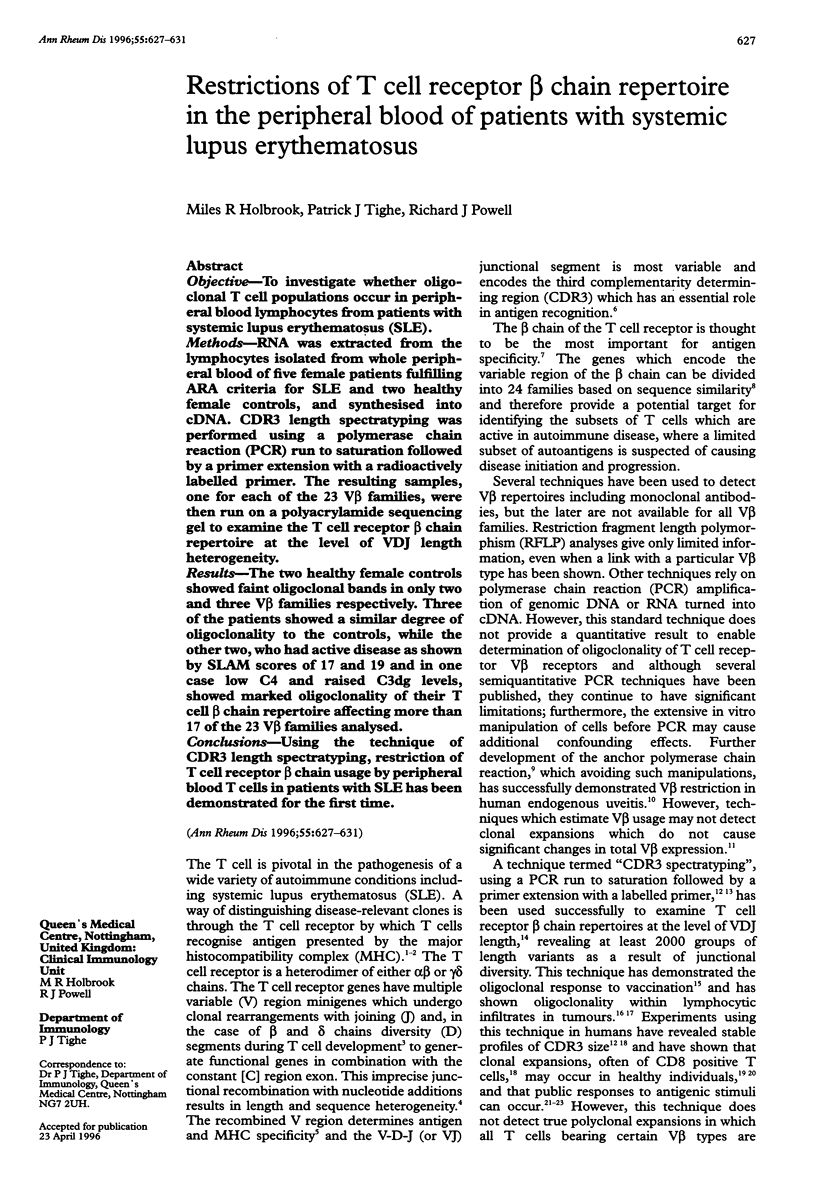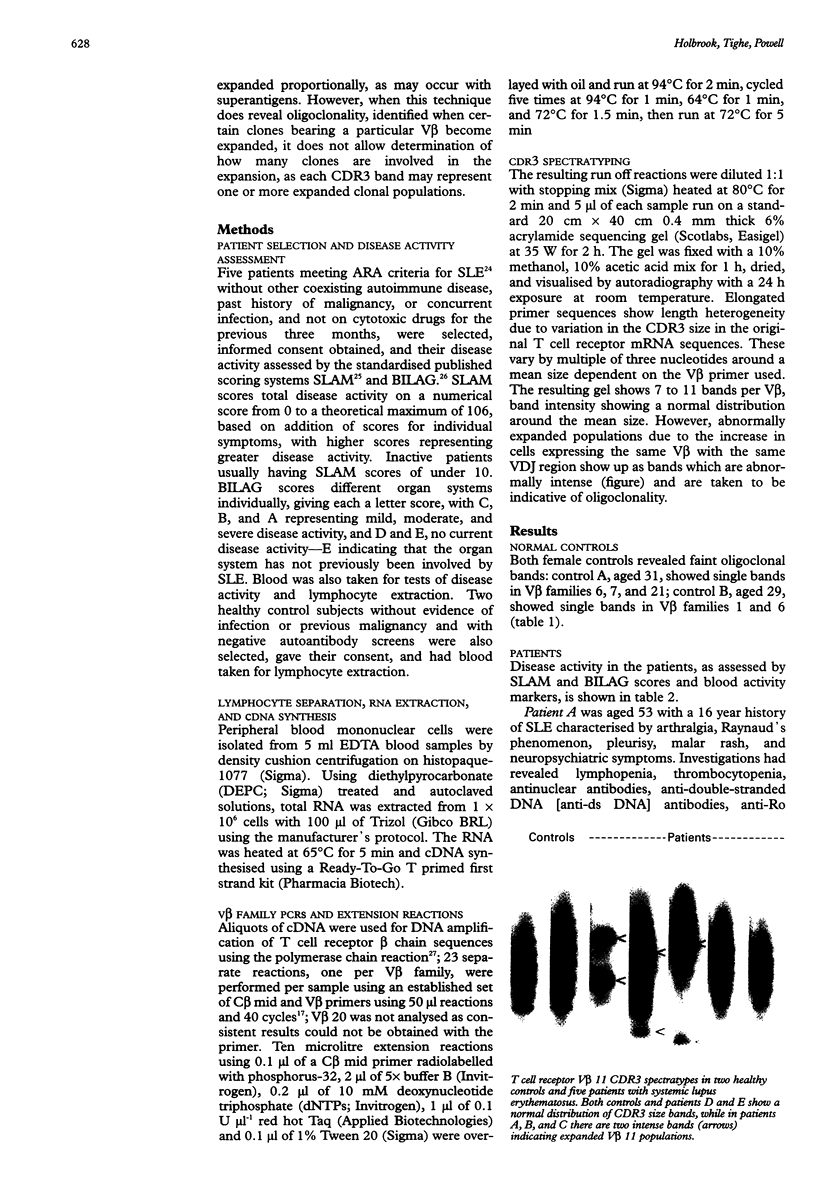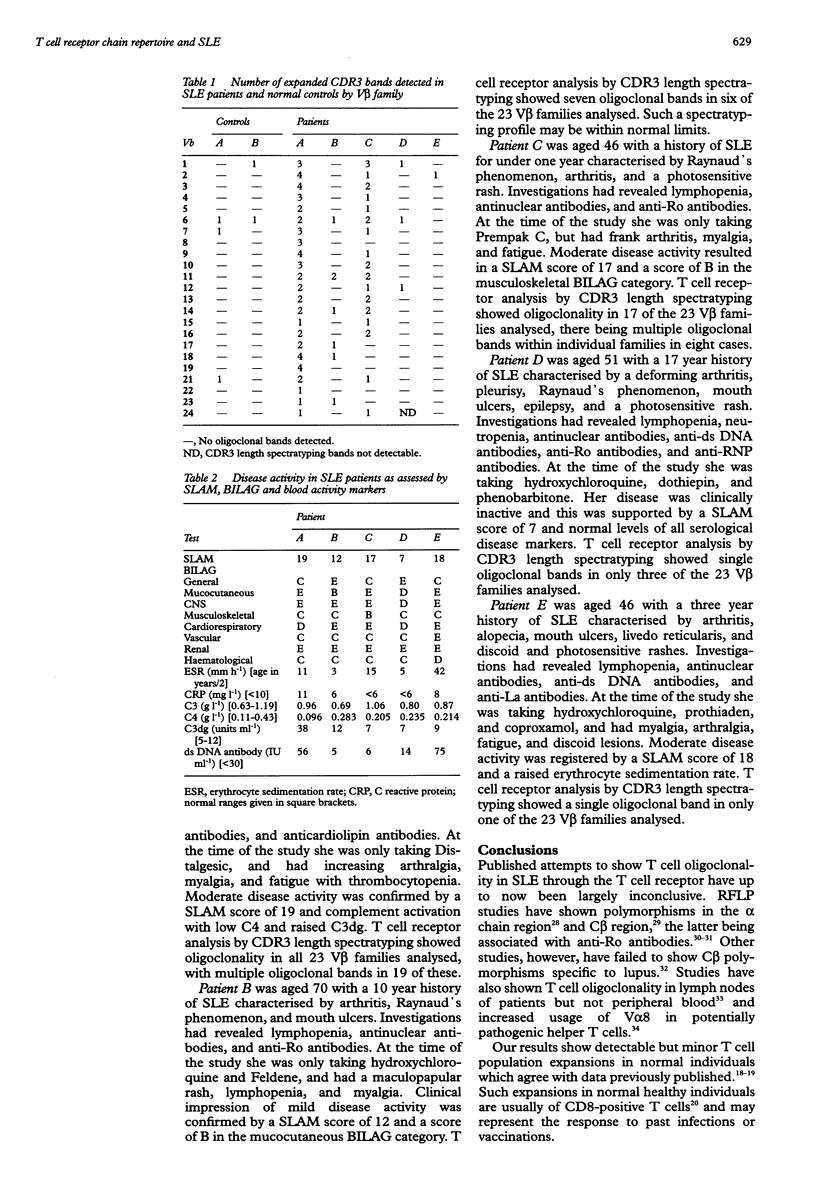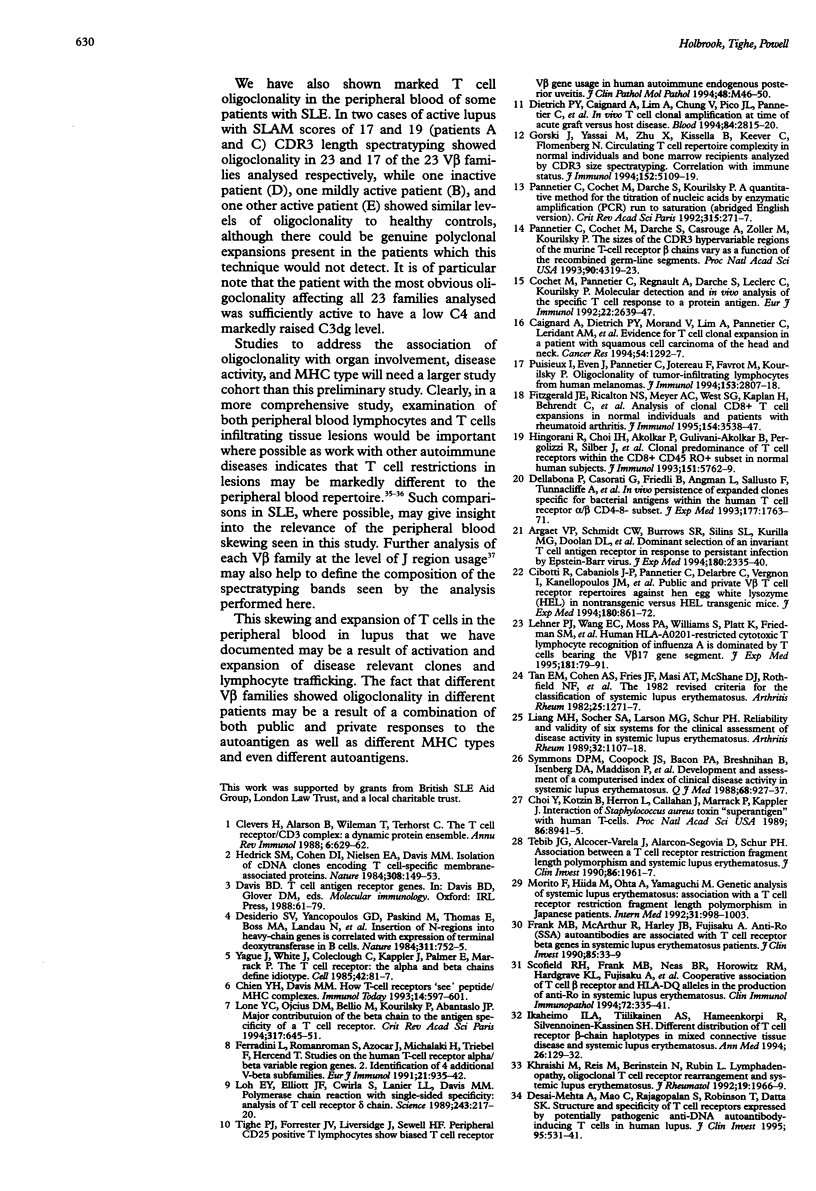Abstract
OBJECTIVE: To investigate whether oligoclonal T cell populations occur in peripheral blood lymphocytes from patients with systemic lupus erythematosus (SLE). METHODS: RNA was extracted from the lymphocytes isolated from whole peripheral blood of five female patients fulfilling ARA criteria for SLE and two healthy female controls, and synthesised into cDNA. CDR3 length spectratyping was performed using a polymerase chain reaction (PCR) run to saturation followed by a primer extension with a radioactively labelled primer. The resulting samples, one for each of the 23 V beta families, were then run on a polyacrylamide sequencing gel to examine the T cell receptor beta chain repertoire at the level of VDJ length heterogeneity. RESULTS: The two healthy female controls showed faint oligoclonal bands in only two and three V beta families respectively. Three of the patients showed a similar degree of oligoclonality to the controls, while the other two, who had active disease as shown by SLAM scores of 17 and 19 and in one case low C4 and raised C3dg levels, showed marked oligoclonality of their T cell beta chain repertoire affecting more than 17 of the 23 V beta families analysed. CONCLUSIONS: Using the technique of CDR3 length spectratyping, restriction of T cell receptor beta chain usage by peripheral blood T cells in patients with SLE has been demonstrated for the first time.
Full text
PDF




Images in this article
Selected References
These references are in PubMed. This may not be the complete list of references from this article.
- Argaet V. P., Schmidt C. W., Burrows S. R., Silins S. L., Kurilla M. G., Doolan D. L., Suhrbier A., Moss D. J., Kieff E., Sculley T. B. Dominant selection of an invariant T cell antigen receptor in response to persistent infection by Epstein-Barr virus. J Exp Med. 1994 Dec 1;180(6):2335–2340. doi: 10.1084/jem.180.6.2335. [DOI] [PMC free article] [PubMed] [Google Scholar]
- Caignard A., Dietrich P. Y., Morand V., Lim A., Pannetier C., Leridant A. M., Hercend T., Even J., Kourilsky P., Triebel F. Evidence for T-cell clonal expansion in a patient with squamous cell carcinoma of the head and neck. Cancer Res. 1994 Mar 1;54(5):1292–1297. [PubMed] [Google Scholar]
- Chien Y. H., Davis M. M. How alpha beta T-cell receptors 'see' peptide/MHC complexes. Immunol Today. 1993 Dec;14(12):597–602. doi: 10.1016/0167-5699(93)90199-u. [DOI] [PubMed] [Google Scholar]
- Choi Y. W., Kotzin B., Herron L., Callahan J., Marrack P., Kappler J. Interaction of Staphylococcus aureus toxin "superantigens" with human T cells. Proc Natl Acad Sci U S A. 1989 Nov;86(22):8941–8945. doi: 10.1073/pnas.86.22.8941. [DOI] [PMC free article] [PubMed] [Google Scholar]
- Cibotti R., Cabaniols J. P., Pannetier C., Delarbre C., Vergnon I., Kanellopoulos J. M., Kourilsky P. Public and private V beta T cell receptor repertoires against hen egg white lysozyme (HEL) in nontransgenic versus HEL transgenic mice. J Exp Med. 1994 Sep 1;180(3):861–872. doi: 10.1084/jem.180.3.861. [DOI] [PMC free article] [PubMed] [Google Scholar]
- Clevers H., Alarcon B., Wileman T., Terhorst C. The T cell receptor/CD3 complex: a dynamic protein ensemble. Annu Rev Immunol. 1988;6:629–662. doi: 10.1146/annurev.iy.06.040188.003213. [DOI] [PubMed] [Google Scholar]
- Cochet M., Pannetier C., Regnault A., Darche S., Leclerc C., Kourilsky P. Molecular detection and in vivo analysis of the specific T cell response to a protein antigen. Eur J Immunol. 1992 Oct;22(10):2639–2647. doi: 10.1002/eji.1830221025. [DOI] [PubMed] [Google Scholar]
- Cochet M., Pannetier C., Regnault A., Darche S., Leclerc C., Kourilsky P. Molecular detection and in vivo analysis of the specific T cell response to a protein antigen. Eur J Immunol. 1992 Oct;22(10):2639–2647. doi: 10.1002/eji.1830221025. [DOI] [PubMed] [Google Scholar]
- Dellabona P., Casorati G., Friedli B., Angman L., Sallusto F., Tunnacliffe A., Roosneek E., Lanzavecchia A. In vivo persistence of expanded clones specific for bacterial antigens within the human T cell receptor alpha/beta CD4-8- subset. J Exp Med. 1993 Jun 1;177(6):1763–1771. doi: 10.1084/jem.177.6.1763. [DOI] [PMC free article] [PubMed] [Google Scholar]
- Desai-Mehta A., Mao C., Rajagopalan S., Robinson T., Datta S. K. Structure and specificity of T cell receptors expressed by potentially pathogenic anti-DNA autoantibody-inducing T cells in human lupus. J Clin Invest. 1995 Feb;95(2):531–541. doi: 10.1172/JCI117695. [DOI] [PMC free article] [PubMed] [Google Scholar]
- Desiderio S. V., Yancopoulos G. D., Paskind M., Thomas E., Boss M. A., Landau N., Alt F. W., Baltimore D. Insertion of N regions into heavy-chain genes is correlated with expression of terminal deoxytransferase in B cells. Nature. 1984 Oct 25;311(5988):752–755. doi: 10.1038/311752a0. [DOI] [PubMed] [Google Scholar]
- Dietrich P. Y., Caignard A., Lim A., Chung V., Pico J. L., Pannetier C., Kourilsky P., Hercend T., Even J., Triebel F. In vivo T-cell clonal amplification at time of acute graft-versus-host disease. Blood. 1994 Oct 15;84(8):2815–2820. [PubMed] [Google Scholar]
- Ferradini L., Roman-Roman S., Azocar J., Michalaki H., Triebel F., Hercend T. Studies on the human T cell receptor alpha/beta variable region genes. II. Identification of four additional V beta subfamilies. Eur J Immunol. 1991 Apr;21(4):935–942. doi: 10.1002/eji.1830210412. [DOI] [PubMed] [Google Scholar]
- Fitzgerald J. E., Ricalton N. S., Meyer A. C., West S. G., Kaplan H., Behrendt C., Kotzin B. L. Analysis of clonal CD8+ T cell expansions in normal individuals and patients with rheumatoid arthritis. J Immunol. 1995 Apr 1;154(7):3538–3547. [PubMed] [Google Scholar]
- Frank M. B., McArthur R., Harley J. B., Fujisaku A. Anti-Ro(SSA) autoantibodies are associated with T cell receptor beta genes in systemic lupus erythematosus patients. J Clin Invest. 1990 Jan;85(1):33–39. doi: 10.1172/JCI114430. [DOI] [PMC free article] [PubMed] [Google Scholar]
- Gorski J., Yassai M., Zhu X., Kissela B., Kissella B [corrected to Kissela B. ]., Keever C., Flomenberg N. Circulating T cell repertoire complexity in normal individuals and bone marrow recipients analyzed by CDR3 size spectratyping. Correlation with immune status. J Immunol. 1994 May 15;152(10):5109–5119. [PubMed] [Google Scholar]
- Hedrick S. M., Cohen D. I., Nielsen E. A., Davis M. M. Isolation of cDNA clones encoding T cell-specific membrane-associated proteins. Nature. 1984 Mar 8;308(5955):149–153. doi: 10.1038/308149a0. [DOI] [PubMed] [Google Scholar]
- Hingorani R., Choi I. H., Akolkar P., Gulwani-Akolkar B., Pergolizzi R., Silver J., Gregersen P. K. Clonal predominance of T cell receptors within the CD8+ CD45RO+ subset in normal human subjects. J Immunol. 1993 Nov 15;151(10):5762–5769. [PubMed] [Google Scholar]
- Ikäheimo I. L., Tiilikainen A. S., Hämeenkorpi R., Silvennoinen-Kassinen S. H. Different distribution of T cell receptor beta-chain haplotypes in mixed connective tissue disease and systemic lupus erythematosus. Ann Med. 1994 Apr;26(2):129–132. doi: 10.3109/07853899409147342. [DOI] [PubMed] [Google Scholar]
- Khraishi M., Reis M., Berinstein N., Rubin L. Lymphadenopathy, oligoclonal T cell receptor rearrangement and systemic lupus erythematosus. J Rheumatol. 1992 Dec;19(12):1966–1969. [PubMed] [Google Scholar]
- Lehner P. J., Wang E. C., Moss P. A., Williams S., Platt K., Friedman S. M., Bell J. I., Borysiewicz L. K. Human HLA-A0201-restricted cytotoxic T lymphocyte recognition of influenza A is dominated by T cells bearing the V beta 17 gene segment. J Exp Med. 1995 Jan 1;181(1):79–91. doi: 10.1084/jem.181.1.79. [DOI] [PMC free article] [PubMed] [Google Scholar]
- Liang M. H., Socher S. A., Larson M. G., Schur P. H. Reliability and validity of six systems for the clinical assessment of disease activity in systemic lupus erythematosus. Arthritis Rheum. 1989 Sep;32(9):1107–1118. doi: 10.1002/anr.1780320909. [DOI] [PubMed] [Google Scholar]
- Loh E. Y., Elliott J. F., Cwirla S., Lanier L. L., Davis M. M. Polymerase chain reaction with single-sided specificity: analysis of T cell receptor delta chain. Science. 1989 Jan 13;243(4888):217–220. doi: 10.1126/science.2463672. [DOI] [PubMed] [Google Scholar]
- Lone Y. C., Ojcius D. M., Bellio M., Kourilsky P., Abastado J. P. Major contribution of the beta chain to the antigen specificity of a T cell receptor. C R Acad Sci III. 1994 Jul;317(7):645–651. [PubMed] [Google Scholar]
- Lunardi C., Marguerie C., So A. K. An altered repertoire of T cell receptor V gene expression by rheumatoid synovial fluid T lymphocytes. Clin Exp Immunol. 1992 Dec;90(3):440–446. doi: 10.1111/j.1365-2249.1992.tb05865.x. [DOI] [PMC free article] [PubMed] [Google Scholar]
- Morito F., Hiida M., Ohta A., Yamaguchi M. Genetic analysis of systemic lupus erythematosus: association with a T cell receptor restriction fragment length polymorphism in Japanese patients. Intern Med. 1992 Aug;31(8):998–1003. doi: 10.2169/internalmedicine.31.998. [DOI] [PubMed] [Google Scholar]
- Pannetier C., Cochet M., Darche S., Casrouge A., Zöller M., Kourilsky P. The sizes of the CDR3 hypervariable regions of the murine T-cell receptor beta chains vary as a function of the recombined germ-line segments. Proc Natl Acad Sci U S A. 1993 May 1;90(9):4319–4323. doi: 10.1073/pnas.90.9.4319. [DOI] [PMC free article] [PubMed] [Google Scholar]
- Puisieux I., Even J., Pannetier C., Jotereau F., Favrot M., Kourilsky P. Oligoclonality of tumor-infiltrating lymphocytes from human melanomas. J Immunol. 1994 Sep 15;153(6):2807–2818. [PubMed] [Google Scholar]
- Scofield R. H., Frank M. B., Neas B. R., Horowitz R. M., Hardgrave K. L., Fujisaku A., McArthur R., Harley J. B. Cooperative association of T cell beta receptor and HLA-DQ alleles in the production of anti-Ro in systemic lupus erythematosus. Clin Immunol Immunopathol. 1994 Sep;72(3):335–341. doi: 10.1006/clin.1994.1150. [DOI] [PubMed] [Google Scholar]
- Symmons D. P., Coppock J. S., Bacon P. A., Bresnihan B., Isenberg D. A., Maddison P., McHugh N., Snaith M. L., Zoma A. S. Development and assessment of a computerized index of clinical disease activity in systemic lupus erythematosus. Members of the British Isles Lupus Assessment Group (BILAG). Q J Med. 1988 Nov;69(259):927–937. [PubMed] [Google Scholar]
- Tan E. M., Cohen A. S., Fries J. F., Masi A. T., McShane D. J., Rothfield N. F., Schaller J. G., Talal N., Winchester R. J. The 1982 revised criteria for the classification of systemic lupus erythematosus. Arthritis Rheum. 1982 Nov;25(11):1271–1277. doi: 10.1002/art.1780251101. [DOI] [PubMed] [Google Scholar]
- Tebib J. G., Alcocer-Varela J., Alarcon-Segovia D., Schur P. H. Association between a T cell receptor restriction fragment length polymorphism and systemic lupus erythematosus. J Clin Invest. 1990 Dec;86(6):1961–1967. doi: 10.1172/JCI114930. [DOI] [PMC free article] [PubMed] [Google Scholar]
- Tighe P. J., Forrester J. V., Liversidge J., Sewell H. F. Peripheral CD25 positive T lymphocytes with biased T cell receptor Vbeta gene usage in autoimmune endogenous posterior uveitis. Clin Mol Pathol. 1995 Feb;48(1):M46–M50. doi: 10.1136/mp.48.1.m46. [DOI] [PMC free article] [PubMed] [Google Scholar]
- Yagüe J., White J., Coleclough C., Kappler J., Palmer E., Marrack P. The T cell receptor: the alpha and beta chains define idiotype, and antigen and MHC specificity. Cell. 1985 Aug;42(1):81–87. doi: 10.1016/s0092-8674(85)80103-3. [DOI] [PubMed] [Google Scholar]



